Wednesday, 18 June 2014
Distance 28 km
Duration 7 hours 15 minutes
Ascent 719 m, descent 446 m
Map 162 of the TOP100 lime-green series
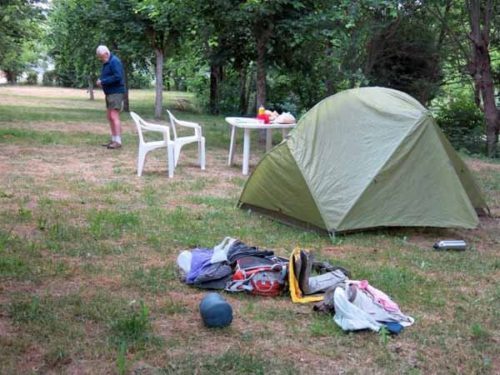
With the dawn came the chorus, an enthusiastic cacophony of chirping and chattering from the trees along the river. We know nothing of the birds of Europe and seldom see any of them. The only one that we hear later in the day is a dove, whose insistent, doleful murmur is impossible to get away from.
We packed up inexpertly (it was our first morning, after all) and ate a bit of muesli with powdered milk and a couple of dried peaches, sitting comfortably at the borrowed table. This was just to get ourselves going and at 6:50 am we set off.
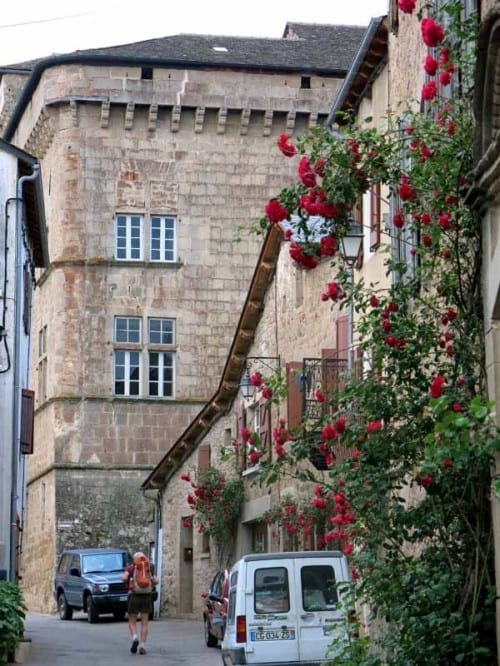
The bar and the shop were both lifeless at that hour, but we had hopes of coffee and croissants at the next village, about ten kilometres away.
The upper part of St-Beauzély was a pleasant surprise after the plainness of the buildings along the main road. A narrow, crooked street climbed between stone houses, some with carved lintels and arches, and nearly all adorned with climbing roses.
There was bitumen on the street but we were sure there were cobbles underneath waiting to be exposed. Further up in a small square were the church and the massive, round-cornered château.
One of the nearby buildings carried a faded sign, “Hotel du Centre”, a vestige of a different age.

Beyond the houses, the GR contoured around the hillside on what was clearly a very well made old route, paved with large flat stones and walled on both sides.
In places where the surface was bare rock, we saw the grooves worn by centuries of cart wheels, which we had been so impressed with last year on the Régordane.
Apparently these grooves were only partly the result of wear – they were sometimes intentionally gouged into the rock to prevent the wheels of the carts from slipping sideways.
We left the terraced fields of the village and began to descend through a beautifully light deciduous forest.
At the bottom we joined a road, or rather the road borrowed a section of the old route, and we swung around the head of a torrent, then left the bitumen again.

The GR went directly uphill and we soon found ourselves wading through tall, dew-laden grasses and cow parsley. Fortunately we had the stone walls on either side to keep us on the track.
After some time we came to a road that was not marked on our map and we mistook it for the road further on, where we had to turn right.
We had only gone a few steps along this road when a car came past and the driver stopped, got out and kindly told us that we were going the wrong way. He pointed to a GR sign that we had missed, on a gate set back from the road and half-hidden in the bushes. We had only seen the gate closer to the road, which for some reason had no sign. This is the sort of polite helpfulness that makes us love the French.
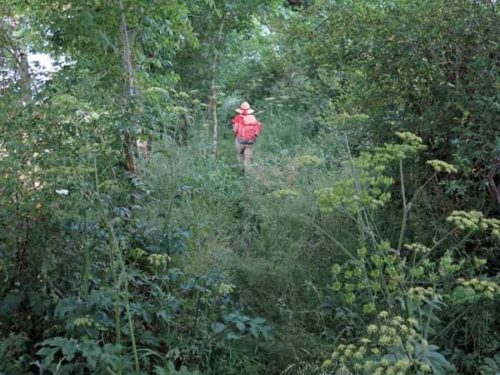
Continuing on our weedy way, we did come to the road we wanted, the D30, just above the hamlet of Estalane. We were pleased to be able to put one foot in front of the other unhindered after the tangled vegetation that we had been struggling through.
The road went down for a while in a pine forest, then the GR turned off steeply uphill. We did not like the look of it and decided to stay on the road, thinking that the GR was unnecessarily going over a hill and would come back down to road level. This was a mistake.
The road soon started to go up itself and took much longer to do it, with the result that by the time we rejoined the GR, we had climbed the same amount and had walked at least a kilometre further.
By this time we were flagging from lack of food, and took the shortest way to the next village, namely along the road.
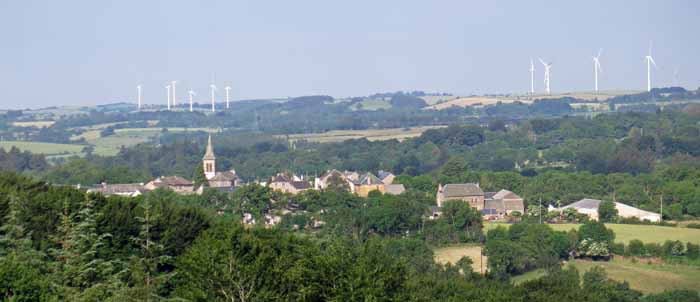
It was not at all busy and we eventually arrived at a saddle which was crowded with wind turbines. Up close they looked monstrous, dwarfing the tall conifers around them.
As we came down the road and caught a glimpse of the village of Bouloc, we hoped that the closing day of the local bar (if indeed there was one) would not be Wednesday.
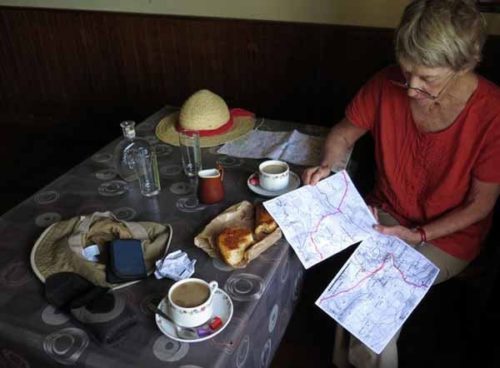
Half an hour later we swung into the main street and saw a boulangerie, where we bought a croissant and a chausson aux pruneaux, having first asked about a bar – yes, there was one a little further on, at the hotel.
Most of the houses were of brown pebbly stone, with brown shutters, and the hotel was no different. It was a rather grim three-story place in a small square, without so much as an umbrella or an outdoor table to relieve it, but the door opened when we tried it, and we found ourselves in a dark, empty, silent room.
A woman crept out wordlessly and made coffee for us. It was not the most festive atmosphere, but we were delighted, as it was our first proper refreshment since leaving Millau, and the coffee was excellent.
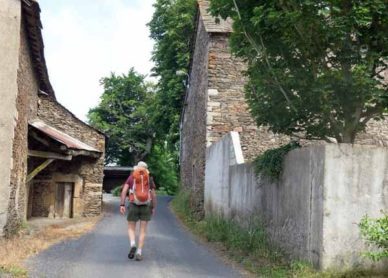
Fortified and encouraged, we marched off, not following the GR but taking a small road and then a forest track, past Salvages and Martouret. Once again we had given in to our urge to invent our own route.

Emerging into fields, we crossed the highway (the D993) amongst an army of gigantic wind turbines and plunged immediately into a dense descending forest.

The track was spongy with last year’s fallen leaves and we went down a long way before we got to the valley.
Here we picked up a small dead-end road and followed it to the left for a long way beside the stream. The GR then rejoined our route and soon afterwards we saw the first houses of Salles-Curan above us.

With a bit of a scramble we got up into the centre of the town, just near a cylindrical tower.
The main street was full of cafés and it was lunch time, but we had coffee only. It is not our habit to have lunch in a restaurant, especially when we are sure, as we were this time, of a restaurant meal that evening.
We drank our coffee at an outdoor table, protected by a screen from the cold wind. Then, following the GR, we strolled down the steep street and curved around under the knot of grey rooves that pressed against the church.
We were now on a fairly busy highway but there was no getting off it until we had crossed the bridge which went over an arm of the large artificial Lac de Pareloup.
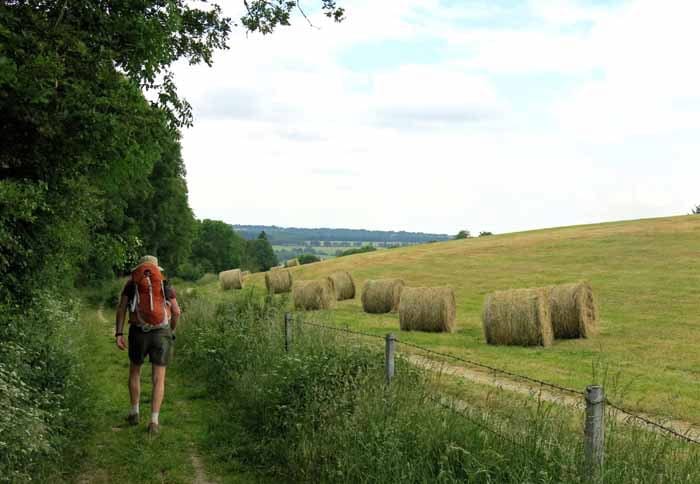
On the other side, the GR made a sudden dash away from the road and up a rocky path behind some barns, into a pastoral landscape that seemed infinitely far removed from the bustling modernity that we had just left.
This quiet interlude ended after half an hour when we descended to join the road again at a second bridge.
There were camping grounds at both ends of the bridge but we pressed on a couple of kilometres until we were near the turn-off to Canet-de-Salars.
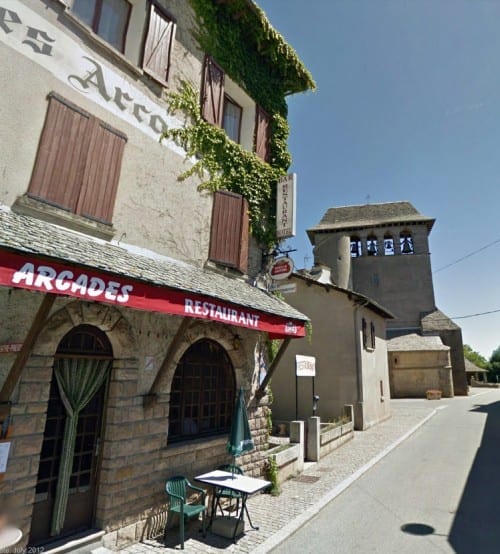
The GR was uncharacteristically clearly marked here, and for once we did not miss the point where it diverged from the bitumen. The rest of our walk to the village was on a path running parallel to the road in a wood, a much pleasanter entry.
Coming up towards Canet-de-Salars, the first thing we saw was the impressive grey church with its segmented belfry, and soon we were walking past its mighty flank. It was one of those villages that resembled a little boy trying on his father’s jacket – too small to do it justice. Nevertheless we got the feeling, from its well-tended look, that the church was the pride and joy of the inhabitants.
Just past the church was a little bar and épicerie, but the shutters were down, so we went along a few more steps to a handsome hotel/restaurant (Auberge des Arcades), which had tables outside and an open door. There was only a lunch menu on the board so we needed to enquire about the evening.
Inside, two pasty-faced men were slumped on a sofa watching English football on a large screen TV. Without stirring, one of them said that the restaurant was closed in the evening (he pronounced it “fur-may”).

I asked whether there was anywhere else for us to get food, as we had none with us, and he replied that the épicerie closed at 2 o’clock (it was now nearly 3). Then they turned their attention unhelpfully back to the TV and left us to back out.
We took it as an example of the difference between English and French manners, which was probably quite unfair.
Deeply despondent, we wandered along the street, and a little way past the edge of the houses we came to an “aire de camping-car” – an unattended place where camping cars can stop for the night, empty their bowels and refill with water.

This one was better than the usual strip of bitumen, as it had lawns and trees as well as a toilet and a single tap. Normally tents are not allowed in these places, but we did not care.
Our choices were: to stay where we were and eat scraps from last night’s meagre meal, to go back to the hotel and ask for a room on condition that they provided a meal, or to continue to the larger town of Pont-de-Salars, about 8 km further on, and stay in a hotel there. We were exhausted and we had taken a great dislike to the owners of the hotel, so we chose the former.
We lay on our mats in a slightly discreet place behind the change rooms of the local sports club, but a storm was approaching so we put up the tent and continued our slumbers inside.
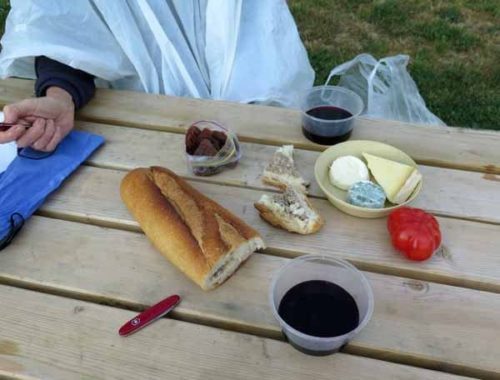
When the thunder and rain stopped, we had an early dinner at a picnic table, under the gaze of the elderly couples in their vans on the grass nearby. There was a cold breeze and we had to wear our plastic rain capes over all our other clothes.
We were grateful for the two little goat cheeses given to us by the sweet woman at St-Beauzély, as there was precious little else to eat – the left-over half of yesterday’s baguette, a tomato, a piece of hard cheese, a scrape of paté and the remains of the bottle of wine.
Having eaten this cheerless meal, we retired to the tent, unwashed and still in our walking clothes, and slept very well.
Previous day: Millau to St-Beauzély